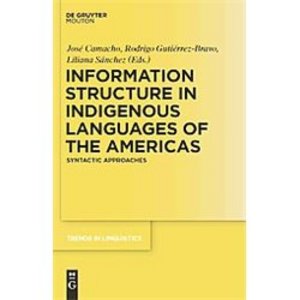Language contact and pragmatic notions: Tariana in its multilingual context
Aikhenvald, Alexandra (2010) Language contact and pragmatic notions: Tariana in its multilingual context. In: Camacho, José , Gutiérrez-Bravo, Rodrigo, and Sánchez, Liliana , (eds.) Information Structure in Indigenous Languages of the Americas: Syntactic Approaches. Trends in Linguistics: Studies and Monographs 225, 225 . De Gruyter Mouton , Berlin, Germany, pp. 17-38.
![[img]](https://researchonline.jcu.edu.au/15781/4.hassmallThumbnailVersion/15781_Aikhenvald_2010_Book_Cover.jpg)
|
Image (JPEG)
Download (11kB) |
|
|
PDF (Published Version)
- Published Version
Restricted to Repository staff only |
Abstract
[Extract] Languages of different typological profiles are known to employ a wide array of morphosyntactic devices to encode information structure (thus supporting Rizzi 1997). In languages with flexible, or discourse-dependent, order of clausal constituents, linear position in a sentence or clause often correlates with marking topic or focus (cf. Pereltsvaig 2004). Alternative grammatical means encoding information structure may include particles encoding focus or topic, as in Urarina, an isolate from Peru (Olawsky 2006; also see cross-linguistic discussion in Lambrecht 1994), specialized marking on verbs (e.g. focus systems in Western Austronesian languages: see Dixon and Aikhenvald 1997 for a brief survey), or dedicated person marking such as proximal-obviative in Algonquian languages (e.g., lunker 2004; also see Frascarelli 2000). Valency-changing or valency-manipulating devices, such as applicatives, may have an additional pragmatic function, casting highly topical participants as core arguments (see Mithun 2001, for a general perspective). North Arawak languages of adjacent areas of Brazil, Venezuela and Colombia employ different sets of personal cross-referencing prefixes for grammatical marking of information structure (see Aikhenvald 1995, on Baniwa of Içana, and Bare; Aikhenvald 1998 on Warekena of Xié).
Tariana, a North Arawak language closely related to Baniwa of lçana, is rather unusual for the Arawak family in that it employs cases on noun phrases as a major means for encoding topical and focal constituents. This is in addition to a plethora of other grammatical means including clausal constituent order, an applicative-like verbal derivation and placement of enclitics. In this paper I investigate the grammatical means for encoding pragmatic notions in Tariana, and outline the dynamics of their development in the situation of intensive language contact with genetically unrelated Tucanoan languages, and the increasingly dominant Portuguese, the local lingua franca.
Tariana is the only Arawak language spoken in the multilingual area of the Vaupés River Basin. Its position, and the role of contact-induced change in its history, are addressed in §2. I then turn to a brief analysis of grammatical means encoding pragmatic notions in the Traditional Tariana (§3). This is accompanied by a comparison with similar patterns in Tucanoan languages. Intensive diffusion of patterns between Tariana and other languages of the area has brought about a plethora of changes in the ways of information structure is marked in the language of innovative speakers (§§4-5). The last section (§6) contains a summary.
| Item ID: | 15781 |
|---|---|
| Item Type: | Book Chapter (Research - B1) |
| ISBN: | 978-3-11-022852-6 |
| Related URLs: | |
| Date Deposited: | 21 Apr 2011 02:47 |
| FoR Codes: | 20 LANGUAGE, COMMUNICATION AND CULTURE > 2004 Linguistics > 200407 Lexicography @ 100% |
| SEO Codes: | 97 EXPANDING KNOWLEDGE > 970120 Expanding Knowledge in Language, Communication and Culture @ 100% |
| Downloads: |
Total: 840 Last 12 Months: 14 |
| More Statistics |



